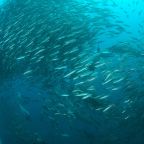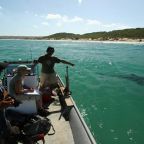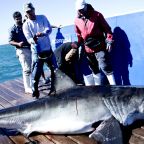In this interview, the Washington post opened up there lines to callers and social media. Some really great questions from the public about sharks and my views on them. This interview was just after the release of the my documentary ‘Sharkville’ where myself and the production crew from Obsessively Creative discovered and documented great white sharks attacking seals at night time… a worlds first.
 Earlier this month in Edgartown on Martha’s Vineyard there were reports of possible aerial sightings of a great white shark which prompted authorities to close two beaches on the popular island off Cape Cod. Shark attacks are extremely rare in waters off New England, but great whites have been known to prowl the region. A typical adult measures 13 to 16 feet with a weight of 1,500 to 2,450 pounds.
Earlier this month in Edgartown on Martha’s Vineyard there were reports of possible aerial sightings of a great white shark which prompted authorities to close two beaches on the popular island off Cape Cod. Shark attacks are extremely rare in waters off New England, but great whites have been known to prowl the region. A typical adult measures 13 to 16 feet with a weight of 1,500 to 2,450 pounds.
No real-life sharks were ever discovered in Edgartown. But particular significance was attached to the news reports because it was in this same location that Steven Spielberg’s 1975 motion picture “Jaws” was filmed in the fictional town of Amity where several attacks occurred in a movie which struck terror in the hearts of beachgoers worldwide.
On Friday night at 10 p.m. ET the National Geographic Channel will air a TV special, Sharkville, about great whites which exemplifies the precision and prowess these tremendous predators possess in action. Video) As formidable as they are, scientists believed great whites only hunted during the day because of poor eyesight … until they got to Sharkville, a shark-infested area just off the southern coast of Africa.
While on a six-year study of great whites, shark expert Ryan Johnson made the discovery of a lifetime — these massive predators hunting seal at night. In the high-definition special, Johnson sets out to capture his findings on camera. Challenged with pointing a night vision camera at just the right time and place, he puts together an astute plan to get his shot.
Johnson was online Friday, July 25, at 2:15 p.m. ET to discuss the special and all things great white.
A transcript follows.
____________________
Silver Spring, Md.: Ryan, you mention that you taught yourself how to free dive with great whales; how?! Any hair raising stories you’d care to share? Thanks, and please be careful.
Dr. Ryan Johnson: How I learned was with a friend of mine, Andre Hartman. He knew how to free dive with white sharks and because I had scientific instrumentation place on the sea floor in great white hot spots I knew I would encounter them. So Andre took be out a couple days and we jumped in the water together.
The first time you jump in the water with a great white shark without a cage you never forget that moment because you can see every gill flutter and movement of its tail that it makes. It’s something that when I close my eyes I remember that first time I hopped in the water like yesterday.
_______________________
Freising, Germany: What are the waters around Sharkville like? I’ve heard that great white sharks are usually found close to seal populations around the world, but do they prefer colder waters rather than warmer tropical waters? How do you think that a general warming of ocean waters will affect great white sharks and seals, their prey?
Dr. Ryan Johnson: Great white sharks have evolved to specialize in hunting marine mammals such as seals. Where the seals hang out is typically in the colder waters so this is where you’re gonna find the great white sharks. How they survive in these waters and remain very fast and powerful predators is by elevating their body temperature above the ambient water temperature.
At present it’s impossible to predict how global warming will affect the great white shark distribution. One of my doctorate students, Enrico Gennari, is trying to answer just that question through understanding their thermal ecophysiology or their ability to control their body temperature in varying water temperatures.
_______________________
Silver Spring, Md.: Mr. Johnson, One marine Biologist to another – what do we need to do to help “ordinary” folks understand that sharks aren’t man eaters at all. It seems that, ever since Jaws, folks are just so . . . irrationally afraid. The number one questions I get when doing public presentations is “Have you ever seen any sharks” followed by “And weren’t you afraid?”
Thanks!
Dr. Ryan Johnson: That’s the most difficult question that all shark conservationists face, trying to remove this irrational fear that many humans have toward sharks. My approach is to try to highlight as many critical behaviors and facts about sharks to try and broaden the public’s appreciation of these creatures.
_______________________
Alexandria, Va.: I keep hearing that because of how sharks have evolved, they are really vulnerable to fishing pressure. Why is this? What can be done to help protect them?
Dr. Ryan Johnson: Sharks as top predators are very slow to reach sexual maturity. They have few offspring and they live a long time (varies for different species). This means if they are fished out their ability of a population to resist fishing pressure is very poor and they are very slow to recover from overfishing.
_______________________
Sterling, Va.: I realize that great whites have an innate “cool” factor…but (out of curiosity) could you give a quick explanation of why we should study them? Clearly there is a lot of research that still needs to be done on the Natural World. What is the importance/impact of studying great whites as opposed to anything else? Thanks!
Dr. Ryan Johnson: As top predators sharks can have a major impact right through the marine food web. To ensure that entire marine ecologies stay stable we have to understand and protect the top of the food chain which is where sharks and the great white are positioned.
_______________________
Washington, D.C.: Can you tell us what we will see in your show tonight?
Dr. Ryan Johnson: The major film shots that we captured were white sharks performing these high-speed ambush breach attacks in the dead of night. This has never been witnessed or documented previously. During our research in 2005 we observed six natural predations at night time. However, to recreate this on camera we used a robotic remote-controlled seal.
The other incredible footage is the abundance of great white sharks in one helicopter shot — seven different great white sharks are captured in one frame. And this type of multiple shark abundance is featured throughout most of the documentary.
_______________________
About Shark Tournaments: Dr.
What are your thoughts on shark tournaments?
Do you think its a brutal event that kills sharks for the glory of a cash prize and the photo op with a bloody carcass on the docks?
Or is it a way for scientists to get to observe and dissect carcasses that they would normally not get a chance to encounter?
Thanks.
Dr. Ryan Johnson: I think it’s a pointless activity which I could never support in any way. Sharks are captured as bicatch in commercial fishing nets and these specimens provide scientists with enough information for all their research needs. If shark fishing tournaments are carried out they should be catch and release and fishers should be taught how to handle a shark to ensure its survival following release.
_______________________
Washington, D.C.: I heard that a bill called the Shark Conservation Act of 2008 passed the House of Representatives earlier this month and that now Sen. John Kerry from Massachusetts has introduced it in the Senate. Do you know anything about this bill and how it would help protect sharks off of Martha’s Vineyard?
Dr. Ryan Johnson: This is one of the most fantastic bills that has been introduced to protect sharks and America is the first country to introduce a bill like this that the entire world of shark scientists and conservationists admires. What it does is make illegal for any fisherman to remove the fins of a shark whilst at sea so that any carcass of a shark is returned to land and is utilized in its entirety. This will stop the incredibly wasteful practice of finning sharks and throwing the carcasses away at sea.
This is legislation I hope the South African government will emulate shortly.
_______________________
Fairfax, Va.: Reading about your appearance here today I did a little Carcharodon carcharias research and came upon the term “intrauterine –cannibalism,” where, after hatching in the female’s uterus, up to 40 embryos must feed off each other until one remains. Fascinating! And that humans are not healthy for great white sharks to eat because the sharks’ digestion is too slow to cope with the human body’s high ratio of bone to meat. And a human’s ability to get to land or onto a boat with the help of others is unusual for a great white’s prey, making most attacks unsuccessful.
I’ve read that Carcharodon carcharias rarely resort to combat with each other, but can they be cannibalistic? Can they actually live to be 100 years old?
In my humble opinion, HD was invented to display nature programs such as yours, and I for one will be eagerly watching tonight!
Dr. Ryan Johnson: Intrauterine cannibalism is a fascinating reproductive strategy that is not utilized by the great white shark but rather by the ragged tooth shark.
In the 1990s scientist Dr. Peter Klimley tried to feed a sheep carcass and a pig carcass to white sharks and found that they rejected the sheep carcass. He hypothesized that it was due to the low fat content. It is possible that this also explains their dislike of humans.
I’ve observed great white sharks biting each other however, these bites are usually not deep or life-threatening but superficial. (Usually this is a contrived situation around our boat)
It’s a million dollar question how old great whites live but most scientists estimate it’s between 30 and 60 years.
_______________________
Washington, D.C.: Hi Ryan,
How prevalent is taking only pieces of sharks in the wild (e.g. fins for shark fin soup, other body parts as aphrodisiacs)? Do you encounter a lot of this?
Thanks.
Dr. Ryan Johnson: It’s incredibly prevalent and probably a lot more than even I estimate. Due to the fact that most of this fishing happens unobserved. Around Africa many of the developing nations don’t have any form of fishing monitoring and huge fishing vessels can do anything with impunity. When I was in Mauritius with National Geographic last month a cyclone arrived and within a day the entire harbor was filled with Asian long-line vessels of which may would have been filled with sharks.
_______________________
Washington, D.C.: How did you get the night images of the sharks? And what other projects are you working on? I love National Geographic Channel. Nice work.
Dr. Ryan Johnson: How we got the images was by utilizing thermal imagery cameras which highlighted the thermal fingerprint of the great whites as they exploded out of the water. The white shark elevates its body temperature 5 degrees Celsius above the ambient water temperature which showed up beautifully on the film. Secondly we used night image intensify cameras which were originally developed for military use but have recently been adapted for filming wildlife at night.
_______________________
Easton, Md.: Hi! Great chat and love the topic. I just have a comment. My brother was recently in Ocean City and while walking on the boardwalk he and his family noticed that some shops was selling live baby sharks. They were sold out apparently but we were all shocked by this. It’s not right. I don’t even like the sale of hermit crabs but sharks? Sad.
Dr. Ryan Johnson: I’ve never heard of anything like this but it does seem a rather shocking practice. With shark fishing you should at least have size limits to ensure that they can reach maturity and reproduce prior to being fished.
_______________________
New York, N.Y.: Why do sharks jump out of the water sometimes, as we recently saw this week in a photograph taken of a surfer with a shark jumping out of the water right behind him?
Also, what are the most frequent causes of death of great whites aside from hunting?
Dr. Ryan Johnson: The jumping out of the water that great white sharks do is a consequence of the high-speed ambush attacks they attempt on seals. They typically patrol at around 10 meters in water depth looking up for silhouettes of seals. When spotted they accelerate as fast as they can vertically to attack the seal and the momentum carries them out of the water in what we call a breach.
_______________________
Arlington, Va.: I was wondering if you, or anyone else for that matter, ever discovered why punching a shark in the nose sends him away on his back.
Dr. Ryan Johnson: I’ve never heard of that happening, that they fall onto their back from punching. One thing that a number of people do with great white sharks is lightly stroke its nose and the sharks will follow the hand and do the mouth opening that is often portrayed in photographs. On a few occasions you can in fact lead the shark over onto its back and it swims away slowly slightly disorientated. (This is what the white shark cage diving operators sometimes do.)
_______________________
Dr. Ryan Johnson: Thank you everyone for your questions. It’s very gratifying how much interest you show in sharks and I hope you enjoy the program this evening.
_______________________
Editor’s Note: washingtonpost.com moderators retain editorial control over Discussions and choose the most relevant questions for guests and hosts; guests and hosts can decline to answer questions. washingtonpost.com is not responsible for any content posted by third parties.











